'The Life of Chuck' Is an Invigorating Drama About Doomsday and Dance. It Wouldn’t Work Without Mandy Moore
The choreographer breaks down the big numbers in the film starring Tom Hiddleston.
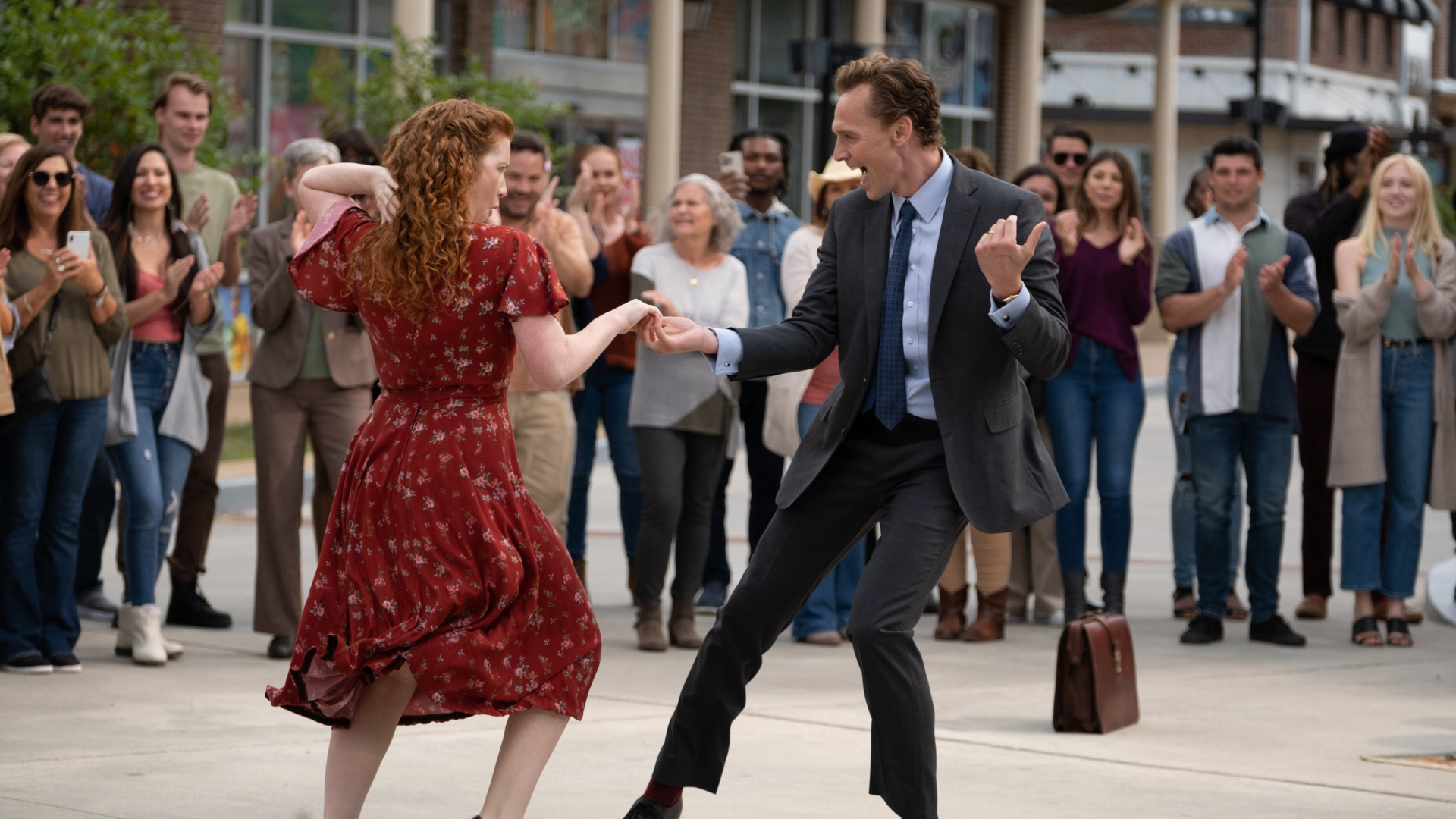
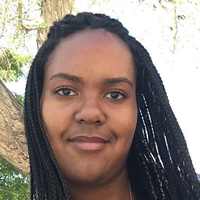
Mike Flanagan’s new film The Life of Chuck begins as a doomsday tale, as small-town residents facing the end of the world are distracted by omnipresent ads celebrating a man named Chuck Krantz (played by Tom Hiddleston). As it continues in reverse chronological order, the movie, adapted from Stephen King's novella of the same name, reveals its true strength as a genre-bending drama about all the joys that give existence its worth despite its inevitable end. For Chuck, that lifelong joy is dance, which proves to be the emotional heart that powers the entire film.
Flanagan tapped choreographer Mandy Moore to infuse her love of movement into each of the film’s standout scenes. Whether they’re aware of it or not, almost every well-versed pop culture fan has become acquainted with Moore’s work. The 49-year-old dancer from Colorado (no relation to the actress of the same name) had already won three Emmys, worked with Taylor Swift, and choreographed Oscar-winning movies like La La Land and Silver Linings Playbook (not to mention the Oscars themselves) before she joined Flanagan’s production. For The Life of Chuck, which follows the titular man’s life in reverse to show how the events of his childhood influence the end of the world, Moore crafted routines that Chuck performs throughout his life. This spans from his middle-school days (then played by Benjamin Pajak) in an after-school dance club, to a seven-minute-long performance between Hiddleston, Annalise Basso, and drummer/recording artist The Pocket Queen (playing a busker) that becomes the most carefree moment of Chuck’s life.
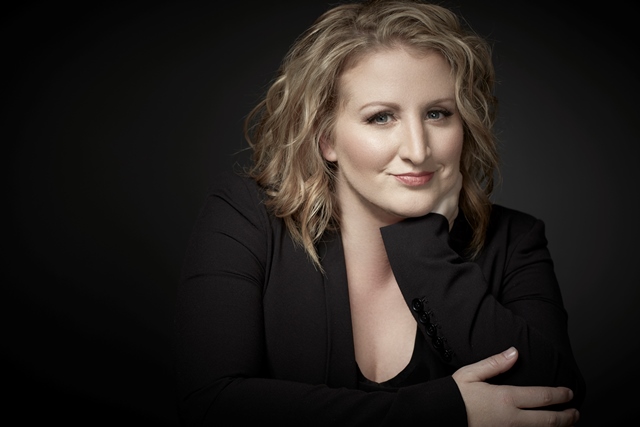
"I really loved that dance played a role in the most casual sense," Moore says of her first reaction to the film. "It wasn't some big performance, or a big musical number, or a dream sequence. It's rooted in real-life situations."
While teaching the choreography, Moore made sure that the actors, who had little to no dance training themselves, were in a similar mood to Chuck when he’s moving: no self-consciousness, no second-guessing, just innocent delight. “Number one, they have to love it,” she tells Marie Claire ahead of the film’s June 6 release. “I never want an actor or a performer to come to dance and hate their life. A big part of it is shielding everyone from all the judgments and the chaos and getting them to feel confident in expressing and moving in a really free way, that it's not about the perfect technique.”
Below, Moore chats with Marie Claire about what went into choreographing the busking performance, making a detour to London to work with Hiddleston, and why she hopes The Life of Chuck will inspire viewers to express themselves.
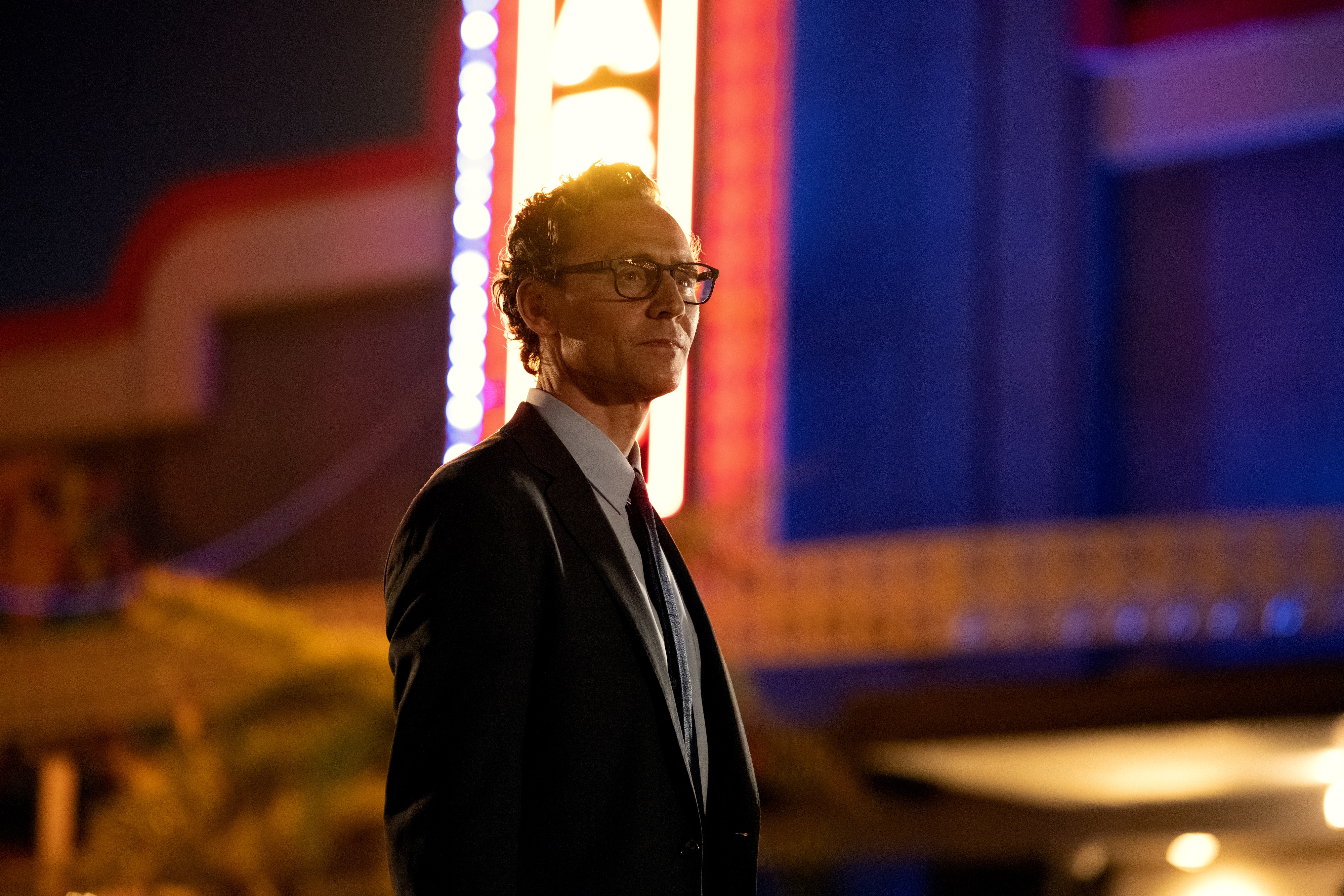
"A big part of it is...getting them to feel confident in expressing and moving in a really free way, that it's not about the perfect technique," Moore says of working with actors like Hiddleston.
Marie Claire: When you first signed on to the film, did you read both the Stephen King novella and the script?
Mandy Moore: I just read the script. When I go into projects, I don't want to sway anything, because the script is my roadmap. So I was sent the script and had my initial meeting with [director] Mike [Flanagan] and Trevor [Macy], one of the producers. The way Mike was talking about how he wanted the dance in the film was so exciting and inspiring. He's not a dancer at all, but he loves dance and movement, and he loved this story. And I really loved that dance played a role in the most casual sense. It wasn't some big performance, or a big musical number, or a dream sequence. It's rooted in real-life situations. I was like, 'Yes, I'm in. This will be so fun.'
MC: For Chuck’s busking dance in the film’s second act, you and Taylor Gordon (a.k.a. The Pocket Queen) crafted the choreography and the drum performance at the same time. What was that like?
Get exclusive access to fashion and beauty trends, hot-off-the-press celebrity news, and more.
MM: It was crazy, honestly. I've never done anything like that, so it was a massive learning curve and the coolest exchange ever. There are so many things that have to land in the scene. You have to believe that Taylor's character is just drumming, bored. And then this guy comes by. He's taken by what he hears. It triggers something that he remembers. Then it becomes this very present back-and-forth interaction between these two humans, these art forms. I was like, 'How are we going to do this drumming track?' The music team had already laid down some ideas, but I thought, We have to get in the room together. I don't know how to make this without Taylor seeing the dance and letting that inform the beat, and then the beat informs the dance.
Another fun part of this is that Tom was in London and I was in L.A., so I had an associate working with Tom, because he's the best and wanted to train and rehearse just like Annalise was in L.A. I would be making things with the L.A. team and sending videos overnight to [assistant choreographer] Stephanie Powell in London for Tom. That was a really cool week of us back and forth, sending videos, sending ideas, sending things to Mike, Taylor coming back with a different rhythm the next day. Usually, I'm just given tracks when I create, but to be able to have one inform the other was really special.
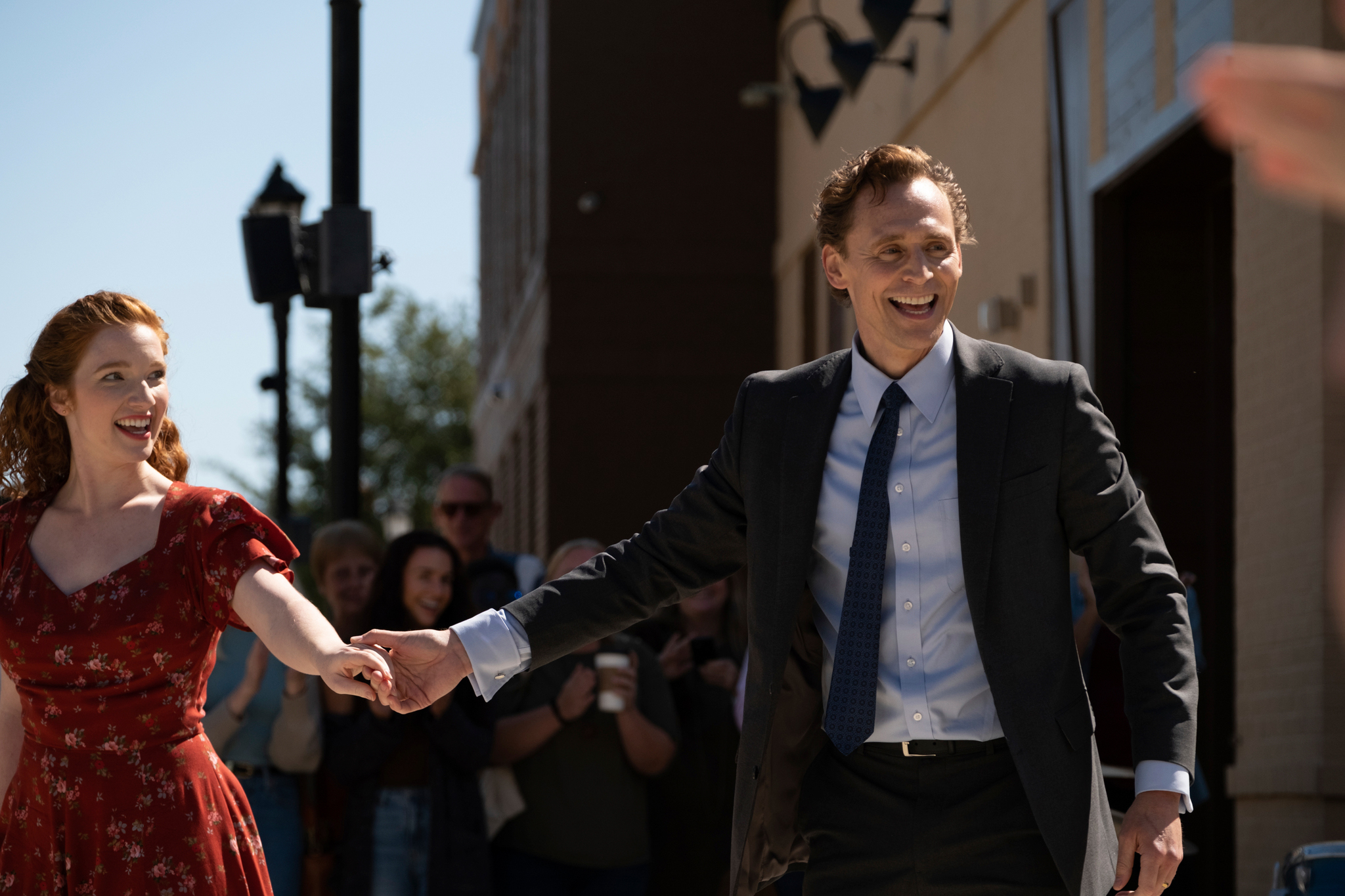
Moore worked with Basso in L.A. and Zoomed with Hiddleston before they held a joint rehearsal in London. "We were finally together in the room. That became a really formative time in the creation."
MC: So in L.A., it was you, Taylor, and Annalise working together?
MM: And [associate choreographer] Jonathan [Redavid]. The first part [of the dance] with Tom was this solo inspiration with the drummer. But then, when he offers his hand to somebody in the audience, it becomes a partner dance. I'm a great partner, but it's much easier if I have my lead counterpart, Jonathan. I would make it up with Jonathan, and then I'd have Jonathan partner with Annalise so she could feel what it would be like with somebody leading her. And then the same with Tom in London. I needed to make sure that he could lead Stephanie through the moments.
I also had to morph the styles that Chuck knows, all these social casual dances, [like] cha cha, salsa, foxtrot, mambo. It was crazy to create to these beats, where Taylor was like, 'I think that's like 4/4, maybe we could get—' I was like, 'I don't read music. I know rhythms, vibes, so I feel like ba-dap-bink, or when you go like, ka-dunk-dunk, I want to do this.' So finding a language together was super fun. As long as you've got a clean rhythm, you can usually find whatever within it. We would send stuff to Mike, and he'd be like, 'How the hell did you guys do this?'
MC: Were you also able to work with Tom Hiddleston in person?
MM: The original plan was that we were all going to meet in Alabama for a couple days right before we shot. I felt really passionately that we needed to be together prior to Alabama. I went to Trevor and Mike and said, 'I think we need to go to London.' Tom couldn't come to Alabama any sooner or L.A., so they flew Taylor, Annalise, and myself over to London for three or four days. But that ended up being the gold, because we were finally together in the room. That became a really formative time in the creation.
It also was great because Mike would Zoom in and give us notes or thoughts at the end of the rehearsal. It was like 4:00 a.m. for him or something. But it was cool because by the time we got to Alabama, it was just about putting the piece in the space, fine-tuning, and then Mike being able to see it from all the different angles and how he wanted to shoot it.
MC: In a previous interview, Mike Flanagan said that the dance scene prioritized “exuberance” over “precision.” Was that ethos also part of your process of teaching Tom and Annalise?
MM: 1000 percent. A huge part of it is teaching basics in the beginning and moving your body. Like, ‘How do you express yourself? How do you find patterns? How do you find your coordination, your textures?’ I don't like mirrors in a room because I think people get very judgmental about the way they look when they're dancing, especially if they have a predisposed 'I'm not a dancer' thing. A big part of it is being like, 'Okay, I'm here to let you know if it looks good or not, and I will let you know,' and getting them to feel confident in expressing and moving in a really free way, that it's not about the perfect technique.

Sam Yarborough (Carl Lumbly) and Marty Anderson (Chiwetel Ejiofor) meet under one of Chuck's congratulation banners.
MC: I loved the adults’ dance in hindsight after seeing Chuck’s childhood and learning that he participated in that dance club. How did you approach weaving all the different ballroom styles into the adults’ dance and having it feel natural?
MM: When you read the script, it's this character who danced with his grandmother in the kitchen. So what are styles that the grandmother might do? Where does she come from? It's like breaking down her character, her time period, her music, what she would like. But he is also a kid who loves the moonwalk, so he's an MTV kid. But also the grandma played MGM musicals for him, so he's got Fred and Ginger, Gene Kelly in his brain. And then he's in a dance class after school that is very sweet and very amateur with these basic styles. Once I did a mood board of all these things that you could draw from, all of the styles came easily.
I was an MTV kid. I remember watching Michael Jackson do the moonwalk and seeing the way his feet moved. So, I can imagine that through a child's eyes, and then how that might manifest through an adult. It was fun to dissect the characters, and it was a heady process, which is fun with dance. I don't always get to do the heady process. Usually, I just have to do the wham-bam-awesomeness process.
MC: That makes sense that you had such an intricate process, because dance is the emotional heart of the entire film.
MM: No pressure. When I first read it, I was like, 'Oh, this is sweet.' And then I realized, 'Oh, my god, these are really pivotal scenes.' Mike was the best to work with. First of all, he's a great director, but I loved that he wanted to talk about dance, what it should feel like, and what he wanted to understand and take from it. He also kept it as it was. He was like, 'I'm not cutting this thing within an inch of his life and cutting it down to two seconds. It needs to live a full existence.' I was like, 'Who is this guy? Yes, he's the best.'
I hope [audiences] walk away wanting to dance. I hope they want to move their bodies and not feel all the judgment and the things that happen in life that make us not want to do those things.
MC: Were you also involved in the process of shooting the middle-school dance club sequences as well?
MM: All of it. I think if you had known I was a part of it, I wouldn't have done my job right. We had to organize and cast these very normal kids. I worked a lot with Samantha Sloyan, who played the coach, to identify the key parts that might need to be taught. But then I didn't really rehearse with most of the kids. I rehearsed a lot with Benjamin [Pajak] and Trinity Jo-Li Bliss, who did the dance with him in the gym. But in the dance club scenes, the kids were literally learning it on the day, which made for the sweetest reactions. They had no clue what they were doing, which was the best to see how they naturally moved. That was purposeful because if they had been too perfect, it wouldn't have looked right.
MC: What was it like working with Samantha Sloyan in her performance as the dance teacher?
MM: We rehearsed in L.A. and then also in Alabama. She would record me teaching her, and I'd send her YouTube links of people teaching basic steps. That has to be terrifying if you're not a dancer and you have to play a character pretending that you really know how to dance and teach. She was great because she really was like, 'Okay, I need to know what that word is or that tone,' or she said, 'That's interesting the way you count like that.' She needed to know the basics, but it was more like, How do you run a room? She would watch me teach Annalise as well, and see the different ways I might ask Annalise to do something or give her a note. Then I think Samantha took all of that along with Mike's stuff, and that's how you got those scenes.
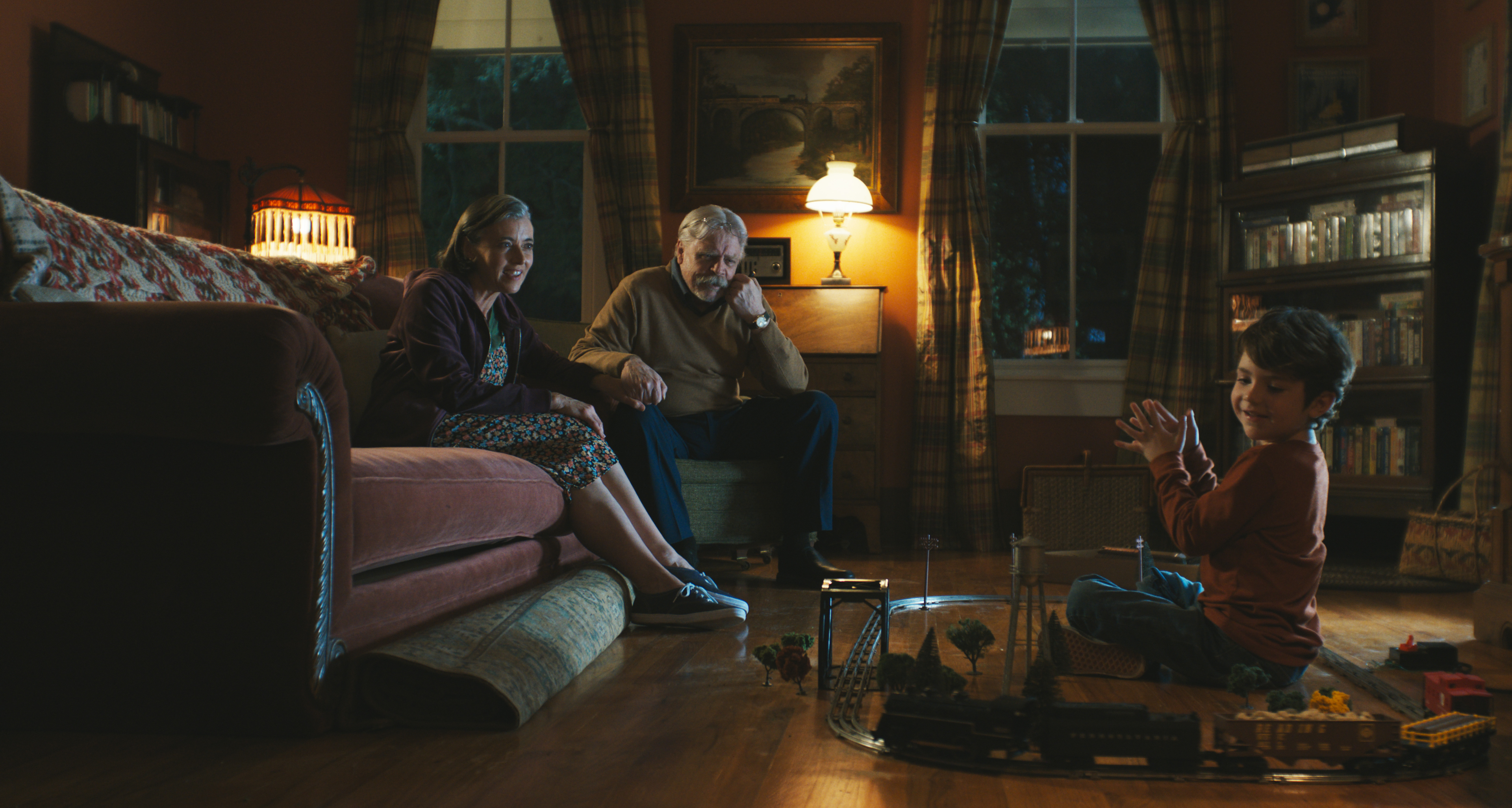
Young Chuck (Cody Flanagan, right) plays with his grandparents (played by Mia Sara and Mark Hamill).
MC: What was it like working with Benjamin Pajak and Trinity Jo-Li Bliss on the gym scene?
MM: Benjamin had done some musical theater, so he's got a little bit of dance, but immediately his mom was like, 'He's not a dancer.' And Trinity was like, 'I don't dance at all.' So their process was very similar to Tom and Annalise's. I had to get in there and teach them basics. Giving them breakdown videos of the moonwalk was very cute. They had homework every night, and they'd have to go practice. I had so much fun creating that dance, too, because [in the story] these kids just made this thing up together. I really tried to put myself into their brains and their bodies, and I could imagine them going like, 'Oh, this step would be cool. Why don't we do one of these?' And like, 'This is fun. Why don't we try this?' To see those two really grab onto that dance and then be able to perform it in such a beautiful way, and that end when she kisses him on the cheek, it was really cute.
MC: Once you’ve seen the full movie, you realize that the adults’ and kids’ dances are in conversation with each other. Could you describe your mindset of having those two scenes juxtaposed against each other while you were choreographing them?
MM: One of the things that I think really worked in our favor is that we shot Tom and Annalise's scene first, so I knew the mecca. I knew the [adult version], and then I was able to fragment the next parts with Trinity and Benjamin. I was like, 'Oh, now I know who Chuck is as an adult, and how he moves in that adult body.' And also being able to have Benjamin on set. Benjamin watched Tom dance on one of Tom's last days, and there were some moves in there—I call them the Tom legs, because it's very Tom Hiddleston—I was like, 'Benjamin, you need to watch those legs, because you have the same step in your dance. I just haven't taught it to you yet. So I want you to watch it and make sure that you see the style.'
The two dances are very different. To me, they're the same egg from a different perspective. You're looking at the same ball of freedom and joy and expression, but from different perspectives and different times in your life. Funny enough, the little kids’ dance was easy to put together after I'd put the adult dance together, because I knew kind of where that was going to end. But maybe if it had been shot in the reverse, that might have been a little bit harder.
MC: What do you hope that audiences will take away after seeing your choreography and this film as a whole?
MM: I hope [audiences] walk away wanting to dance. I hope they want to move their bodies and not feel all the judgment and the things that happen in life that make us not want to do those things. If it's dance for you, or if it's baking, or painting—whatever the thing is that you stop yourself from doing in your own mind, I hope that you walk out and go like, 'You know what? Screw it. I'm going to do that thing that I've always wanted to do or that I forgot that I love to do.' That would be the dream.
I'm so sad for the arts right now, in general. I wish there were more opportunities for all kinds of people and all ages to do things that are artful and expressive, because it's important. I think it's a huge part of what makes people human.
This interview has been edited and condensed for clarity.
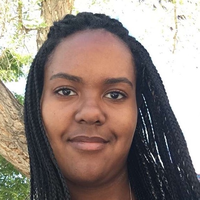
Quinci LeGardye is a Culture Writer at Marie Claire. She currently lives in her hometown of Los Angeles after periods living in NYC and Albuquerque, where she earned a Bachelor’s degree in English and Psychology from The University of New Mexico. In 2021, she joined Marie Claire as a contributor, becoming a full-time writer for the brand in 2024. She contributes day-to-day-content covering television, movies, books, and pop culture in general. She has also written features, profiles, recaps, personal essays, and cultural criticism for outlets including Harper’s Bazaar, Elle, HuffPost, Teen Vogue, Vulture, The A.V. Club, Catapult, and others. When she isn't writing or checking Twitter way too often, you can find her watching the latest K-drama, or giving a concert performance in her car.